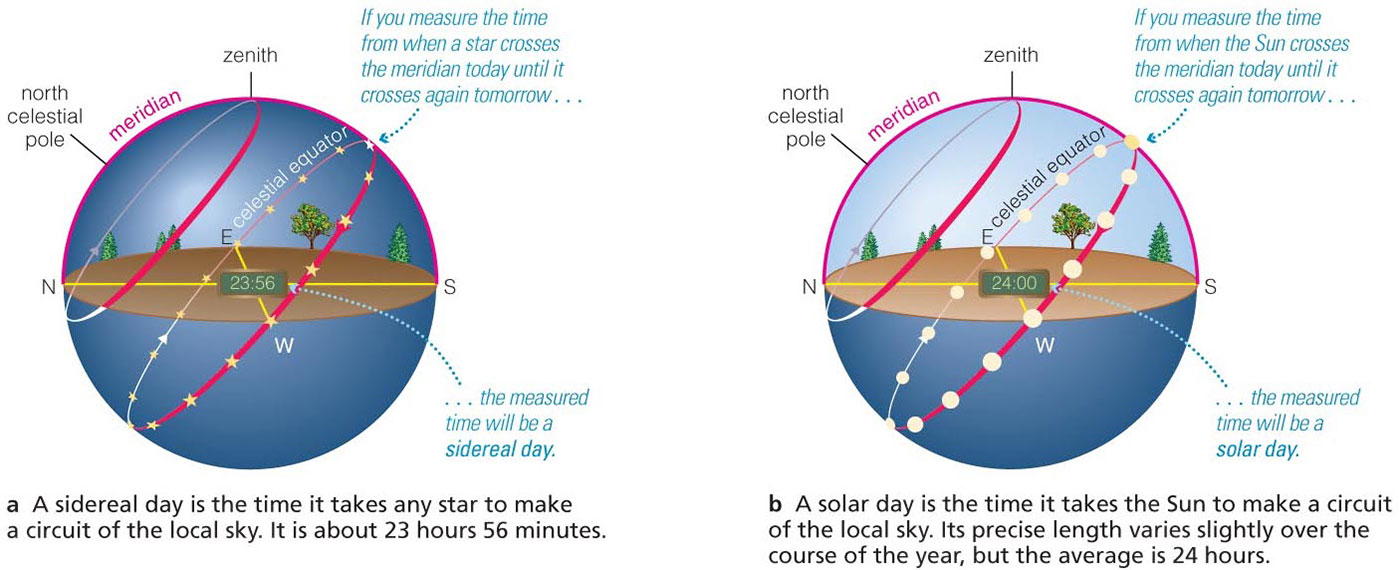Is a day exactly 24 hours?
We usually think of a “day” as being 24 hours, just as it is on our clocks. But it turns out that if we want to be very precise, there are a couple of complications to this idea. To understand why, you have to think about how we measure a “day.” Before you read on, think of how you might measure it for yourself.
The basic way that we measure the length of day is to see how long it takes for the Sun to make a complete circuit around our sky. For example, you could start a watch at your local noon one day (meaning the time when the Sun is on your local meridian) and stop it at noon the next day. If you do this many times throughout the year, you’ll find that on average, the time from noon one day to noon the next is exactly 24 hours. That is why we use 24-hour clocks.
Now consider the same type of measurement for a star in the night sky. That is, pick some bright star at the moment it crosses your median, then time how long it takes until it is on the meridian again the next night. No matter what star you pick, you’ll find that the time it takes for a circuit around your sky is about 23 hours and 56 minutes, or about 4 minutes short of 24 hours. In other words, the length of “day” as measured by the stars is about 4 minutes shorter than the length of a “day” as measured by the Sun. Figure 1 below summarizes these different measurements. Notice that a day by the stars is called a sidereal day (because sidereal means “related to the stars”) and a day by the Sun is called a solar day .

Figure 2a shows a simple demonstration that will show you why a “day” by the stars is different from a “day” by the Sun. Set an object representing the Sun on a table, and stand a few steps away to represent Earth. Point at the Sun and imagine that you also happen to be pointing toward a distant star that lies in the same direction. If you rotate (counterclockwise) while standing in place, you’ll again be pointing at both the Sun and the star after one full rotation. However, to show that Earth also orbits the Sun, you should take a couple of steps around the Sun (counterclockwise) as you rotate. In that case, after one full rotation, you will again be pointing in the direction of the distant star, so this represents a day by the stars (a sidereal day). But notice that you need to rotate a little extra to point back at the Sun, which is why the solar day is slightly longer than the sidereal day.
Figure 2b shows how this idea applies to the real Earth. Because Earth completes a 360° orbit around the Sun in 365 days (a year), Earth travels about 1° around its orbit each day. So while one full rotation (360°) of Earth represents the sidereal day of about 23 hours and 56 minutes, a solar day requires about 361° of rotation. This extra 1° of rotation therefore takes about 1/360 of Earth’s rotation period—which is about 4 minutes (to see this, just divide the number of minutes in a sidereal day by 360).

You now understand the first complication in defining a “day”, which is that our 24-hour solar day is slightly longer than Earth’s actual rotation period because of the fact that Earth is orbiting the Sun at the same time.
The second complication is that 24 hours is the average length of the solar day, but its exact length can vary by up to about 25 seconds over the course of the year. The reason is that Earth’s orbit around the Sun is not a perfect circle, and Earth travels slightly faster around its orbit when it is closer to the Sun and slightly slower when it is farther from the Sun. This means that during the faster part of the orbit, a solar day requires a little more than the average of about 1° of extra rotation, and during the slower part it requires a little less.
To summarize:
- Earth’s actual rotation period is about 23 hours, 56 minutes. We call this a sidereal day, because we measure it by the stars (and sidereal means “related to the stars”).
- Our 24-hour clocks are based on time by the Sun, and this solar day is slightly longer than Earth’s actual rotation period because of our orbital motion around the Sun.
- The average length of the solar day is exactly 24 hours. However, the length of the solar day varies slightly (by up to about 25 seconds) over the course of the year, because of Earth’s varying orbital speed around the Sun.
Note: The following video summarizes the difference between a solar and sidereal day. Notice how Earth’s orbital motion causes the sidereal day to be shorter than the solar day, just as in the demonstration described in Figure 2 above.